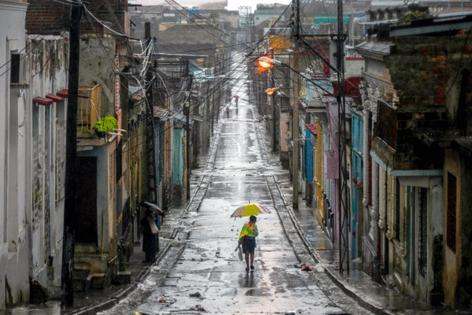After Hurricane Melissa, a flood of damage. Followed by a flood of fake AI videos
Published in News & Features
No, there weren’t schools of sharks circling in resort pools in Jamaica. No, a commercial plane didn’t get a bird’s eye view above the center of the storm. And no, there weren’t crowds swimming in Hurricane Melissa’s floodwaters on the streets.
While damage reports coming out of Cuba and Jamaica after Hurricane Melissa are awful, some of the images and videos circulating on social media are just awfully fake.
But in the last month, multiple companies have launched new versions of artificial intelligence-powered video generators, like Sora 2 from OpenAI or Meta’s Vibes app. Those videos, some with the watermarks cropped or blurred, have deluged social media in the wake of Hurricane Melissa.
Some have gone viral. One image, purporting to show a damaged waterfront hospital in Jamaica, racked up tens of thousands of shares and likes on X — as well as, eventually, a community note warning it was AI-generated. It also made it into a news story by the New Zealand Herald, which later removed the photo.
“It’s so hard sometimes to determine what’s fact, what’s reality, and what’s absolutely trash and fake,” said Athena Masson, who teaches meteorology at Jacksonville University.
This week was a real-time learning opportunity for her aviation meteorology class. They dissected a trending video purporting to show the eye of Hurricane Melissa from the window of what appeared to be a commercial airliner. While Hurricane Hunters have snapped plenty of chilling shots from inside the eye of Melissa, this one had a much higher vantage point.
“I asked, ‘how far up do your cumulonimbus feet clouds go?’ They said 60,000 feet in rare conditions in the tropics,” Masson said. “You would need oxygen tanks and a specialized aircraft. It’s obviously fake.”
With the advent of improved AI-generated photos and videos, it’s much more difficult to pick out the fakes these days, she said. Gone are the days of hands with an unnerving amount of fingers or a Will Smith clone slurping spaghetti in a manner that can only be described as disturbing.
For instance, Masson was scrolling X on Tuesday and noticed a video depicting Jamaicans swimming in the floodwaters that filled their streets. There was plenty of actual life-threatening flooding that left mud smeared on main roads and cars tossed aside like toys.
But as she watched the video a few times, she noticed a few details that were off.
“There’s too many people in the water, and they’re swimming like they would at a resort and not like you would in floodwater, grasping on to things, trying to survive,” she said.
Masson tells her students to run through a mental checklist when trying to determine whether a hurricane video is AI or real:
1. Check the comments. Sometimes experts (or even careful viewers) will point out inaccuracies. That does get harder on some accounts trying to drum up engagement with fake videos — also known as ragebait — which delete any comments trying to suss out AI.
2. Look carefully at the image. Are the colors oversaturated? Does the visible text on signs or paper make sense? Are the people in the video moving like a normal human would?
3. Use critical thinking. Check the account that posted the video and see if they have posted similar or relevant content in the past. Ask yourself if it makes sense that someone would have photographed that moment so clearly.
In the immediate wake of Hurricane Melissa, power has been out across Jamaica. And during the hours the eye crossed the island, it was blowing dangerously hard and dumping heavy rain. Not ideal conditions to shoot video.
“You are not taking very clear pictures and videos and posting them on the web somehow when the power is down,” Masson said.
_____
©2025 Miami Herald. Visit miamiherald.com. Distributed by Tribune Content Agency, LLC.







Comments